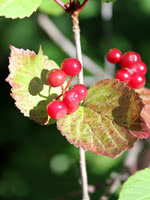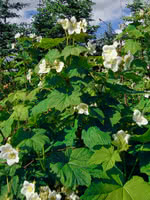Mon-Fri 9am - 5pm Mountain time
Lowbush Cranberry vs Thimbleberry
Viburnum edule
Rubus parviflorus
NOT AVAILABLE THIS SEASON - MIGHT RETURN
NOT AVAILABLE THIS SEASON - MIGHT RETURN
Lowbush Cranberry is a short, deciduous shrub native to North America. Its white flowers bear sour but edible fruit that ripens to a brilliant red in fall. Lowbush Cranberry's small size makes it suitable for urban use; buyers will also find it useful if trying to reclaim land back to its original species or when landscaping with native species in damp conditions.
Thimbleberry is an ornamental shrub with large, green maple-like-leaves. Flowers are attractive, fragrant, and turn into red-raspberry-like berries. The berries are good for jams, cakes, breads, muffins etc. If you remove the berry, the core resembles a thimble, giving this shrub its namesake.

